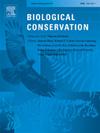Promoting equity in priority area identification for productive lands: A protection-management-restoration hierarchy
IF 4.9
1区 环境科学与生态学
Q1 BIODIVERSITY CONSERVATION
引用次数: 0
Abstract
Priority area identification studies focus on conservation and restoration programs and planning at regional, national, and global scales. However, there are still limitations to the fair interpretation of spatial assessment of trade-offs for various types of land, especially productive land, in sustainable development. Priority area identification should be based on an exact framework to maximize ecological and productive benefits at minimal costs. Therefore, we propose an integrated priority area identification framework based on a “protection-management-restoration” hierarchy and demonstrate our approach at the terrestrial scale in China. We explored the proportion of each land type and the cost-effectiveness under different target levels and hierarchy scenarios, finding that the share of the management hierarchy is larger than the others, and the gap becomes progressively more apparent as the target level increases. Among the various priority areas identified, forests and grasslands have a higher share compared to other land types. We also found that the priority areas identified by the scenarios giving the same weight to each tier protect 30.08 % of the threatened terrestrial vertebrates and 43.48 % of the total manageable carbon at the 30 % target level, and their costs are in the middle of all the scenarios. At the same time, we also emphasize that conservation, management, and restoration are never mutually exclusive and different actions can be highly complementary and carried out simultaneously during planning practices. Our framework provides valuable insights for implementing territorial spatial planning at the national level and offers new perspectives on weighing the ecological and productive benefits of ecosystems.

求助全文
约1分钟内获得全文
求助全文
来源期刊

Biological Conservation
环境科学-环境科学
CiteScore
10.20
自引率
3.40%
发文量
295
审稿时长
61 days
期刊介绍:
Biological Conservation is an international leading journal in the discipline of conservation biology. The journal publishes articles spanning a diverse range of fields that contribute to the biological, sociological, and economic dimensions of conservation and natural resource management. The primary aim of Biological Conservation is the publication of high-quality papers that advance the science and practice of conservation, or which demonstrate the application of conservation principles for natural resource management and policy. Therefore it will be of interest to a broad international readership.
 求助内容:
求助内容: 应助结果提醒方式:
应助结果提醒方式:


